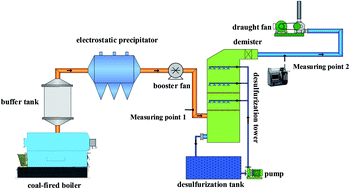Investigation of the emission control of sulfur trioxide aerosols based on heterogeneous condensation and the deflectors tray of the desulfurization tower
Abstract
In this paper, control over the emission of sulfur trioxide aerosols was investigated based on heterogeneous condensation in the wet flue gas desulfurization process. The influence of the deflectors tray of the desulfurization tower on the removal performance of the sulfur trioxide aerosols was also studied. The results show that the critical supersaturation degree of sulfur trioxide aerosols is in inverse proportion to the sizes. Heterogeneous condensation has a significant effect on the reduction of sulfur trioxide aerosols. The number concentration of the sulfur trioxide aerosols with sizes <0.1 μm decreases, while the number concentration of sizes >0.1 μm increases at the outlet with this method. The relative humidity of the flue gas is likely to be the most influential in the formation of a supersaturated environment and the removal of sulfur trioxide aerosols. Addition of the tray in the desulfurization tower also increases the reduction of sulfur trioxide aerosols. Heterogeneous condensation can improve the removal efficiency of sulfur trioxide aerosols by 14.3% as well as the installation of a tray by 21.4%.



 Please wait while we load your content...
Please wait while we load your content...